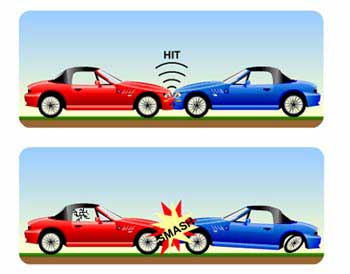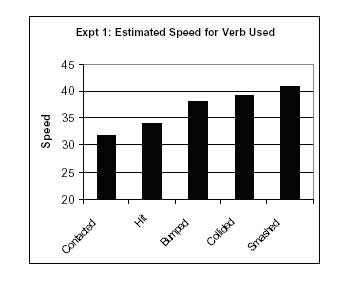On This Page:
Psychologist Elizabeth Loftus has been particularly concerned with how subsequent information can affect an eyewitness’s account of an event.
Her main focus has been on the influence of (mis)leading information in terms of both visual imagery and wording of questions in relation to eyewitness testimony.
A leading question is a question that suggests what answer is desired or leads to the desired answer.
Loftus’ findings seem to indicate that memory for an event that has been witnessed is highly flexible. If someone is exposed to new information during the interval between witnessing the event and recalling it, this new information may have marked effects on what they recall. The original memory can be modified, changed or supplemented.
The fact the eyewitness testimony can be unreliable and influenced by leading questions is illustrated by the classic psychology study by Loftus and Palmer (1974) Reconstruction of Automobile Destruction described below.
Loftus and Palmer (1974) Study
Aim: To test their hypothesis that the language used in eyewitness testimony can alter memory.
Thus, they aimed to show that leading questions could distort eyewitness testimony accounts and so have a confabulating effect, as the account would become distorted by cues provided in the question.
To test this Loftus and Palmer (1974) asked people to estimate the speed of motor vehicles using different forms of questions. Estimating vehicle speed is something people are generally poor at and so they may be more open to suggestion.
Experiment One

Procedure: Forty-five American students from the University of Washington formed an opportunity sample.
This was a laboratory experiment with five conditions, only one of which was experienced by each participant (an independent measures experimental design).
7 films of traffic accidents, ranging in duration from 5 to 30 seconds, were presented in a random order to each group.
After watching the film participants were asked to describe what had happened as if they were eyewitnesses.
They were then asked specific questions, including the question “About how fast were the cars going when they (smashed / collided / bumped / hit / contacted) each other?”
Thus, the IV was the wording of the question and the DV was the speed reported by the participants.

Findings: The estimated speed was affected by the verb used. The verb implied information about the speed, which systematically affected the participants’ memory of the accident.
Participants who were asked the “smashed” question thought the cars were going faster than those who were asked the “hit” question.
The participants in the “smashed” condition reported the highest speed estimate (40.8 mph), followed by “collided” (39.3 mph), “bumped” (38.1 mph), “hit” (34 mph), and “contacted” (31.8 mph) in descending order.
Conclusion: The results show that the verb conveyed an impression of the speed the car was traveling and this altered the participants” perceptions.
In other words, eyewitness testimony might be biased by the way questions are asked after a crime is committed. Loftus and Palmer offer two possible explanations for this result:
- Response-bias factors: The misleading information provided may have simply influenced the answer a person gave (a “response-bias”) but didn”t actually lead to a false memory of the event. For example, the different speed estimates occur because the critical word (e.g. “smash” or “hit”) influences or biases a person’s response.
- The memory representation is altered: The critical verb changes a person’s perception of the accident – some critical words would lead someone to have a perception of the accident being more serious. This perception is then stored in a person’s memory of the event.
If the second explanation is true we would expect participants to remember other details that are not true. Loftus and Palmer tested this in their second experiment.
Experiment Two
A second experiment was conducted with the aim of investigating is leading questions simply create a response bias, or if they actually alter a person’s memory representation.
Procedure: 150 students were shown a one minute film which featured a car driving through the countryside followed by four seconds of a multiple traffic accident.
Afterward, the students were questioned about the film. The independent variable was the type of question asked.
It was manipulated by asking 50 students “how fast were the car going when they hit each other?”, another 50 “how fast were the car going when they smashed each other?”, and the remaining 50 participants were not asked a question at all (i.e. the control group).
One week later the dependent variable was measured – without seeing the film again they answered ten questions, one of which was a critical one randomly placed in the list: “Did you see any broken glass? Yes or no?” There was no broken glass on the original film.
Findings: Participants who were asked how fast the cars were going when they smashed were more likely to report seeing broken glass.

Conclusion: This research suggests that memory is easily distorted by questioning technique and information acquired after the event can merge with original memory causing inaccurate recall or reconstructive memory.
The results from experiment two suggest that this effect is not just due to a response-bias because leading questions actually altered the memory a participant had for the event.
The addition of false details to a memory of an event is referred to as confabulation. This has important implications for the questions used in police interviews of eyewitnesses .
Consequently, Loftus and Palmer support the reconstructive memory hypothesis – arguing that information gathered at the time of an event is modified by data gathered afterwards.
Over time, information from these two sources is integrated to the degree that it is impossible to separate them – in effect we only have one memory
Critical Evaluation
Perhaps the greatest strength of Loftus and Palmer’s experiment is the degree of control over confounding variables . As the study was lab-based, the researchers could ensure that a range of factors (age of participants, incident viewed, environment, etc).
Consequently, they could ensure that these factors did not affect the respondents answers – and that only the verb-condition was causing the participants to re-evaluate their memories
As an psychological explanation, the reconstructive memory hypothesis is extremely useful; for instance, in formulating guidelines in for police questionning of witnesses and suspects.
The study has also had real-world implications; based on evidence such as Loftus’, the Devlin Report (1976) recommended trial judges be required to instruct juries that it is not safe to convict on a single eyewitness testimony alone.
One limitation of the research is that it lacked mundane realism / ecological validity. Participants viewed video clips rather than being present at a real-life accident.
As the video clip does not have the same emotional impact as witnessing a real-life accident the participants would be less likely to pay attention and less motivated to be accurate in their judgements.
Furthermore, when watching a real crash, there is much more context – and the participants had been cued to watch the video, whilst crashes in
real life a largely unexpected.
In an experiment, you may well expect to be asked questions about what you are watching and this may make you attend to the film in a different way.
In real life, there may be consequences arising from the answers that you give and this may put pressure on the witness.
Overall, we can probably conclude that this laboratory experiment had low ecological validity and thusmay not tell us very much about how people’s memories are effected by leading questions in real life.
A study conducted by Yuille and Cutshall (1986) conflicts the findings of this study. They found that misleading information did not alter the memory of people who had witnessed a real armed robbery.
This implies that misleading information may have a greater influence in the lab rather and that Loftus and Palmer’s study may have lacked ecological validity.
He was especially interested in the characteristics of people whom he considered to have achieved their potential as individuals.
A further problem with the study was the use of students as participants. Students are not representative of the general population in a number of ways.
Importantly they may be less experienced drivers and therefore less confident in their ability to estimate speeds. This may have influenced them to be more swayed by the verb in the question.
A strength of the study is it’s easy to replicate (i.e. copy). This is because the method was a laboratory experiment which followed a standardized procedure.
Given that it has just been argued that the study had an unrepresentative sample and had low ecological validity, you might feel that it was not very useful. However, despite the points made above, it is possible to identify a number of practical applications that arise from Loftus and Palmer’s research.
The conclusion that leading questions can affect memory has important implications for interviewing witnesses, both by police immediately or soon after an event and also by lawyers in court some time later.
Interviewers should avoid leading questions and should be careful to word questions in ways that do not suggest an answer to the person that they are interviewing.
It should also be noted that some psychologists have criticized Loftus and Palmer’s conclusions. They argue that we have no way of knowing that the participant’s original memories had been irretrievably altered by the leading questions.
Instead, they suggest that participants could merely be following the suggestions of the researcher in both the original round of questions and the follow-up questions.
In effect, demand characteristics could be “carried forward” – as participants have remembered that they had been asked about the cars “smashing” into each other, they have been prompted to say that they have seen broken glass in the follow up study.
Independent Learning Tasks
- Draw a table showing the results of experiment one and draw a bar chart to show the results of experiment two.
- Read the original article of the study.
- Conduct your own study repeating one of the experiments by Loftus and Palmer.
- Use photographs (or video clips) of car accidents and write a set of questions, one of which will be the critical question.
- Test one group of participants using the “smashed” condition and the other group with the “hit” condition.
- Calculate the mean, median and mode speed estimates for both the “smashed” and “hit” conditions. Illustrate your results in either a table or graph.
Learning Check (1)
- Write an experimental hypothesis for experiment 1. Make sure it is clearly operationalized and include the independent and dependent variables.
- Why was it a good idea to ask 10 questions rather than just asking the critical question alone?
- Why was each group of participants shown the 7 video clips (of car accidents) in a different order?
- Outline the possible sampling technique that may have been used in this study.
- The participants knew they were taking part in a psychology experiment. How do you think this may have effected their behavior?
- Can you think of a way that this problem might of been overcome?
Learning Check (2)
- Write an null hypothesis for experiment 2. Make sure it is clearly operationalized and include the independent and dependent variables.
- What is a “control group”, and why is it necessary?
- What is an “experimental” group?
- Outline one difference between the responses given between the two experimental groups.
- Outline the quantitative measure used in this study.
References
Devlin Committee Report: Report of the Committee on Evidence of Identification in Criminal Cases, 1976 Cmnd 338 134/135, 42
Loftus, E. F., & Palmer, J. C. (1974). Reconstruction of auto-mobile destruction: An example of the interaction between language and memory. Journal of Verbal Learning and Verbal behavior, 13, 585-589.
Yuille, J. C., & Cutshall, J. L. (1986). A case study of eyewitness memory of a crime. Journal of Applied Psychology, 71(2), 291.

